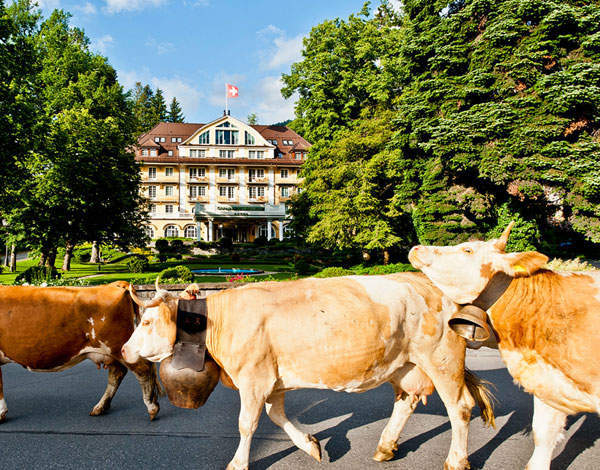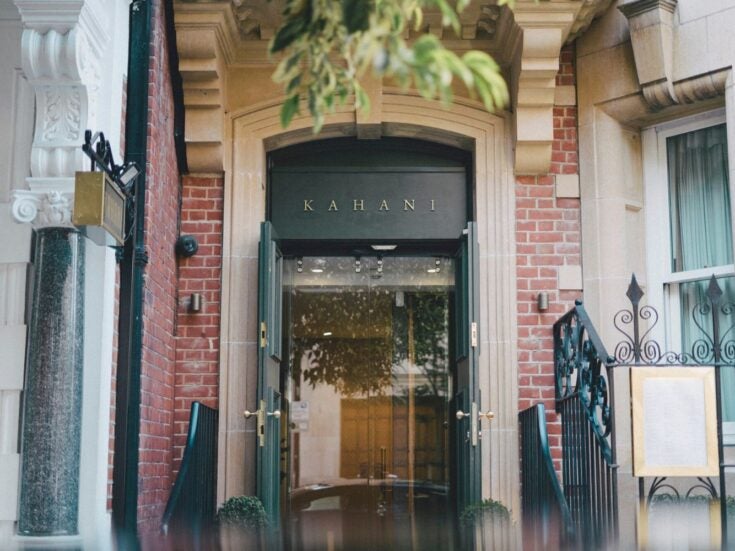

Small Swiss villages are not necessarily known for their food. But then again, Gstaad isn’t your average Swiss village. Yes, you find wandering herds of cows with heavy cowbells swinging from their necks, but you also have wandering crowds of the exceptionally wealthy, laden with diamonds and designer tags.
Gstaad is one of those places with an interesting reputation. Seen as the winter playground of the rich – like an up-market Bicester Village given all of its designer boutiques in quaint buildings – it isn’t necessarily known for its summer activities or indeed its cuisine.
Prior to my recent trip, the last time I’d been in Gstaad was probably six or eight years ago with family, and during the summer, when it simply looked like a toy town. The fur coat and salopette clad clientele of the winter months were missing and replacing them were a few elderly hikers and the odd cow. It didn’t feel like a living, breathing town.
However, on my return at the tail end of the winter this year, things seemed different. Perhaps it was because I was older or because the journey through snow mottled countryside in the beautiful local train was highly therapeutic. In truth it was the abundance of good food that converted me: with 266 Gault & Millau points and three one-Michelin-starred restaurants there is more to Gstaad than skiing, yodeling and expensive shops.
THE GRAND BELLEVUE
Five-star superior hotels are commonplace in Gstaad, from the imposing Gstaad Palace perched above the town to the newly opened Alpina – the first completely new hotel to be built here in over a century. I stayed at the recently refurbished Grand Bellevue, which unlike the other hotels here has a completely different feel – imagine a Firmdale hotel but in the heart of a sleepy village.
It has a modern, pared back aesthetic in the rooms and the lobby and restaurant spaces are inviting rather than imposing. Everything is finished with great attention to detail, from the beautiful typeface on the printed materials around the hotel to the library, which has been painstakingly curated by Daniel Koester, the hotel’s owner.
You won’t find any alpine kitsch here – unless you go to Le Petit Chalet, the hotel’s tiny and very chintzy fondue restaurant in the grounds – but rather rich blue velvets, elegant natural fiber carpets and textiles in understated biscuit tones.
The hotel’s Michelin-starred restaurant, Leonard’s, has an equally modern approach to dining and this was the real reason for my stay. The menu is accessible – a mix of brasserie and fine dining served in a very beautiful dining room. Yes, there are white tablecloths but importantly there isn’t any pretension.
Local produce and traditional dishes are showcased with modern, clean execution. You can order luxurious dishes should you wish – from a deep, rich lobster bisque to poached egg with spinach and a butter laden hollandaise – but Koester was insistent that you should also be able to order a world-class burger from their menu. Not a beautiful, neat, Michelin-ified burger but rather a burger that needs to be picked up with both hands, is messy, looks damned good and tastes even better.
More than anything the inclusion of the burger on a Michelin-starred menu shows attention being paid to gastronomic trends and the desire of punters to be able to have choice. As I mentioned in a piece a few weeks ago, this is Marcus Wareing’s ‘user-friendly’, flexible dining in practice.
Yet despite this move towards a more modern gastronomy, the continued presence of Le Petit Chalet is telling. Run by Gino, the most charming Swiss man I’ve met, they only serve fondue and raclette for mains and make them there and then. It would seem that although people want – and expect – to be able to enjoy international cuisine when on holiday (there are several sushi restaurants in the village, including one in the hotel), the traditional reigns supreme here.
BEST OF GSTAAD
I spoke with Stefanie Krisch of the Gstaad Palace and she confirmed that their fondue offering, La Fromagerie (formerly an underground bunker built by the Swiss National Bank), is perennially their most popular restaurant despite their Italian restaurant being staffed by a team from the Cipriani in Venice during the winter months and there being three more restaurants in the hotel.
This creates a wonderful amount of choice, though, as hotels and restaurants compete to tempt visitors through their doors. There are few destinations of this size (the population is just a little over 3,000) with quite so many fine-dining restaurants. The emphasis here is clearly on entertaining the seasonal visitor and as a result a little micro(gastro)climate has been created in this pocket of Switzerland.
So, apart from the fondue and its oodles of cheese, what are the key ingredients and dishes you should be looking out for when indulging in the mountains? Top of the list is beef from the Simmenthal, which happens to be the favourite local ingredient of Urs Gschwend (head chef at the Bellevue) and forms the filling for a beautiful ravioli dish at Le Grill at the Gstaad Palace.
The local fish from Lake Geneva is wonderfully fresh and I’m told that local farmer Daniel Von Siebenthal has a remarkable array of fresh produce including kale in five or six different colours.
Then of course there is the diary produce from the Gstaad Molkerei, which you will find simmering away in your fondue pot. The quality of each and every ingredient must meet the exacting standards of Gstaad’s international guests, which results in great food being readily, if not cheaply, available. Even if you are not a skier, hiker or people-watcher there is now very good reason to come to Gstaad.
So should you decide to head out from your chosen hotel if you’re in the village or spread your wings a little next time you find yourself in the Swiss mountains, I have compiled a few recommendations from some local experts to help guide you:
Best hot chocolate: Charly’s on the promenade
Best Swiss institution: Le Chesery
Best out of town: Le Comptoir d’Enhaut or Le Braconnier, both in Rougement or16 Bar-Restaurant in Saanen
Michelin stars: Leonard’s at The Grand Bellevue, Sommet at the Alpina and Le Chesery
The fondue in Switzerland is very, very good. Just don’t tell your nutritionist.
Switzerland Tourism
For more information on Switzerland visit www.MySwitzerland.com or call our Switzerland Travel Centre on the International freephone 00800 100 200 30 or e-mail info.uk@myswitzerland.com; for packages, trains and air tickets sales@stc.co.uk.
Swiss International Air Lines.
SWISS offers up to 31 daily flights from London Heathrow, London City, Birmingham and Manchester to either Zurich, Geneva or Basel. Fares start from £123* return, including all airport taxes. (*Please note this is a leading fare and is subject to change, availability and may not be available on all flights. Terms and conditions apply.) For reservations call 0845 601 0956 or visit: www.swiss.com
The Swiss Travel System provides a dedicated range of travel passes and tickets exclusively for visitors from abroad. The Swiss Transfer Ticket covers a round-trip between the airport/Swiss border and your destination. Prices are £96 in second class and £153 in first class.
For the ultimate Swiss rail specialist call Switzerland Travel Centre on 00800 100 200 30 or visit www.swisstravelsystem.co.uk.






